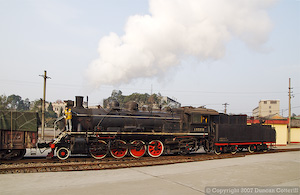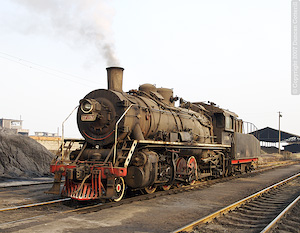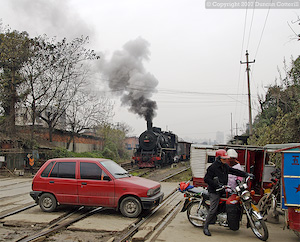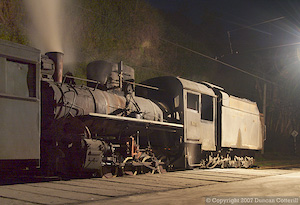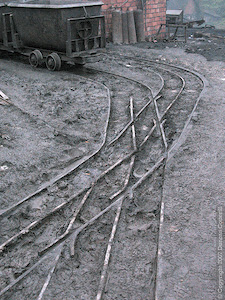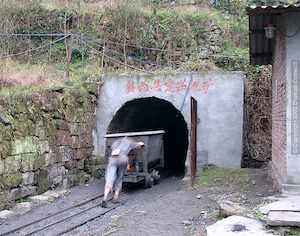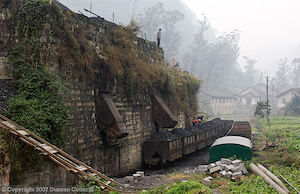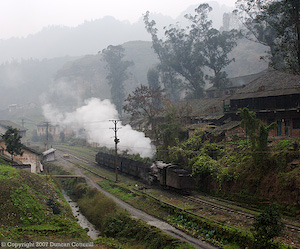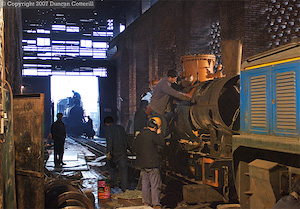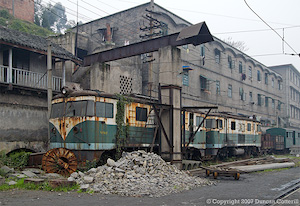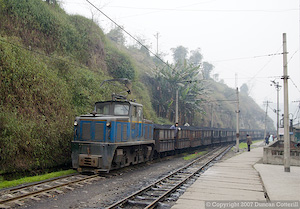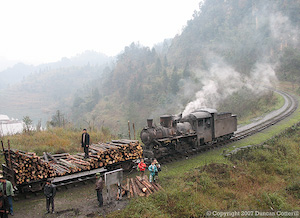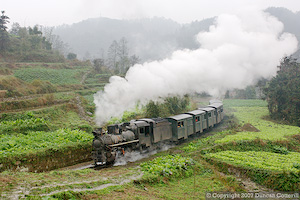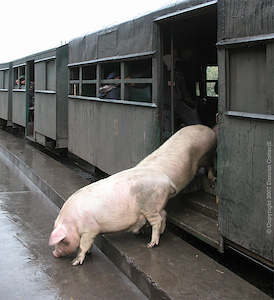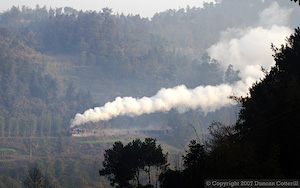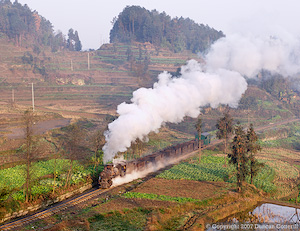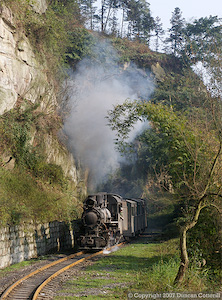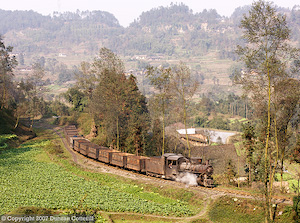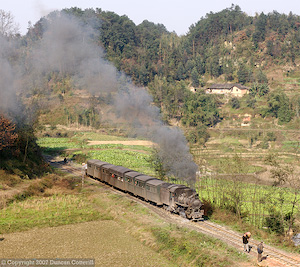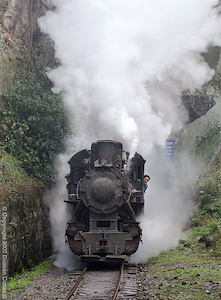Steam in Sichuan
03 - 14 January 2007
Report by Duncan Cotterill
Introduction
Shibanxi had been near the top of my "must visit" list for some time but it was difficult to combine with the best of the remaining steam locations in northern China. There was also a problem deciding when to visit. Winter was dull and wet, the rest of the year was slightly sunnier but without much chance of low sun and cool days. There just didn’t seem to be a good time of year to go to Shibanxi. The opportunity for a short trip arose in January 2007 so we took the plunge and set off for Sichuan to see what all the fuss was about. On the way, there was time to investigate some rarely reported SYs around Chengdu as well. Peter Breeze accompanied me for the whole trip and Robin Gibbons joined us for the week at Shibanxi. As usual, Sun Xiaolan made all the arrangements and accompanied us as guide.
London – Beijing – Chengdu
(03 – 04 Jan 2007)Peter and I took our usual flights from Manchester and London to Paris and on to Beijing with Air France. On arrival we met up with Xiaolan and continued to Chengdu on Air China flight CA4102 at 12:20, arriving Chengdu at 15:00. While in Chengdu we stayed at the Binjiang Hotel in the city centre. We spent the first couple of days checking out a number of locations near Chengdu where steam had been reported in recent years.
Chengdu Seamless Pipe Works
(04 & 06 Jan 2007)From the airport we went to look for steam at the Seamless Pipe Works. Unfortunately the plant had closed and was in the process of being demolished. Production has been moved to a new site adjacent to Chengdu Iron & Steel, north of the city. Surprisingly, some steam working continues at the old site. As we approached the level crossing at the end of the main yard, north of the site, SY 1207 trundled past light engine on its way to the shed. At the depot SY 2008 and 2010 were out of use with rods removed and big ends and slide bars packed. Also present was GK1C 0007, parked between the two SYs. Questioning of the railway staff elicited the information that SY 2008 and 2010 had been sold to a nearby glassworks.
Next task was to locate the glassworks. We found it around 2 km north of the pipe works but staff informed us that there were no locomotives there at the moment. However, they were expecting to receive two locos in the near future. Presumably the site is currently shunted by Seamless Pipe engines and the two SYs will replace them when the pipeworks operation ceases.
A second visit to the Seamless Pipe yard two days later saw SY 1523 arrive at the yard with some wagons from Chengdu Dong at lunchtime. Staff confirmed that there were only two working engines left.
Locos: SY 1207, 1523 in use, SY 2008, 2010, GK1C 0007 stored.
Jiangyou Steelworks
(05 Jan 2007)This operation is located at Jiangyou, a medium sized town approximately 140 km north of Chengdu and famous for being the birthplace of the poet Li Bai. After asking about steam locomotives at the main gate of the steelworks we were surprised to be waved straight through. It didn't take long to find the loco depot where SY 0256, 0671 and 1161 were cold but serviceable and SY 0122 was complete but clearly out of use. 1990 built DFH5B 3019 and 3020 were also at the depot and SY 0378 was shunting nearby. After taking a few photos, we left to find the main yard just north of the steelworks complex where we had been told we would find more locos. SY 1133 was stabled there and SY 0378 passed through light engine. As we were about to leave, steelworks security arrived and demanded to see our photographs. They asked me to delete two shots that showed one of the diesels but were happy with the pictures of the SYs. The diesels were apparently top secret and should not have been photographed! Once the offending boxes were deleted we were free to go.
Locos: SY 0378, 1133 in use, SY 0256, 0671, 1161, DFH5B 3019, 3020 cold serviceable, SY 0122 stored/dumped.
Mianzhu Freight Depot
(05 Jan 2007)On our way back from Jiangyou, we detoured to Mianzhu, on the branch from Deyang to Hanwang. Veteran SY 0045 was found in a small yard a few hundred metres north of the station, supplying steam to a gang cleaning out tank cars. The yard here appeared to be a general freight depot rather than just the ore loading facility previously reported, although it did include an ore loading area. The station was also busy, with freight being loaded into several boxcars. It wasn’t determined whether the SY shunted the station as well or remained in its own yard. The loco showed absolutely no sign of moving while we were there. Staff were unaware of any other steam locos in the Mianzhu area in spite of a recent report of two SYs at a sulphuric acid plant in the town.
Locos: SY 0045 in use.
Hanwang Fertiliser Factory
(05 Jan 2007)From Mianzhu we continued to the end of the branch at Hanwang where SY 0418 was in steam at what appeared to be a disused loading hopper north of the station. The conveyor that had previously supplied the hopper had been removed and there was no obvious means of getting material into it. What the loco was doing there was unclear as it had no obvious work. The old transhipment point at the very end of the branch, where coal had previously been transferred from the narrow gauge electric line, was also out of use. The narrow gauge line itself wasn't checked out. The Dongfang Steam Turbine Works west of the station was being shunted by a small orange Bo-Bo diesel of a type I didn’t recognise.
Meanwhile, another steam engine had appeared at the south end of the station but vanished again before we could get to it. We eventually tracked it down to some sidings at the back of a chemical fertiliser plant on the eastern edge of town. The second loco was SY 1194. Staff at the plant told us that there were two locos, pointing to SY 1194 and indicating one more at the station, assumed to be SY 0418. It wasn’t clear whether both locos belonged to the fertiliser plant. Locals told us that there was usually a trip from the factory to the station around 14:00 to 15:00 every day. The line from the factory climbs steeply on the approach to the station.
SY 0418 and SY 1194 were the two locos reported at the sulphuric acid plant at Mianzhu in 2006. There were sulphuric acid tanks at the fertiliser plant so it’s likely that this was the location that the earlier visitors had been to.
Locos: SY 0418, 1194 in use.
Chengdu Iron & Steel, Xindu
(06 Jan 2006)This is the main steelworks in the Chengdu area and is situated between Xindu and Qingbaijiang, about 25 km north of the city. The Seamless Pipe Works is being relocated to an adjacent site and much construction work is underway. The main steelworks yard and stabling point are just east of the Chengdu – Mianyang Expressway but it’s very difficult to see anything from the road. SY 1511 was in steam at the stabling point and SY 1244, 1390 and 1612 were cold but were all extremely clean and appeared to be in full working order. SY 1244 and 1612 were previously reported at the old Seamless Pipe site. There were also a number of diesels around. GK1C 0358, 0368 and GKD3B 0008 were all noted but there was at least one other GK1C there as well. Security was pretty tight and we were politely refused permission when we asked to have a look at the engines. However, it was possible to see over the wall and identify all the SYs. Several staff we asked said that there were only the four engines left so we didn’t push our luck and try to get into the steelworks proper.
Locos: SY 1511 GK1C 0358, 0368, GKD3B 0008 in use, SY 1244, 1390, 1612 cold serviceable.
Chengdu Area Industrial Steam
| Loco | Builder | Location | Remarks |
| SY 0045 | Tangshan 1967/04 | Mianzhu | |
| SY 0122 | Tangshan 1969/01 | Jiangyou | Dumped |
| SY 0256 | Tangshan 1970/07 | Jiangyou | Cold |
| SY 0378 | Tangshan 1971/06 | Jiangyou | |
| SY 0418 | Tangshan 1971/09 | Hanwang | |
| SY 0671 | Tangshan 1973/05 | Jiangyou | Cold |
| SY 1133 | Tangshan 1981/04 | Jiangyou | |
| SY 1161 | Tangshan 1982/04 | Jiangyou | Cold |
| SY 1194 | Tangshan 1982/10 | Hanwang | |
| SY 1207 | Tangshan 1983/01 | Chengdu SPW | |
| SY 1244 | Tangshan 1983/08 | Chengdu I&S | Cold |
| SY 1390 | Tangshan 1985/08 | Chengdu I&S | Cold |
| SY 1511 | Chengdu I&S | ||
| SY 1523 | Tangshan 1987/02 | Chengdu SPW | |
| SY 1612 | Tangshan 1988/03 | Chengdu I&S | Cold |
| SY 2008 | Jinan 1992 | Chengdu SPW | Stored |
| SY 2010 | Jinan 1992 | Chengdu SPW | Stored |
CNR in the Chengdu Area
(04 – 06 Jan 2007)We didn’t see a lot of activity on the main lines around Chengdu during our stay in the city but what we did see was in line with expectations. There were lots of SS3/SS3B electrics around on freight but the only passenger we got a clear view of was approaching Chengdu Bei from the east behind a passenger DF4D. This could have been a train off the line from Daxian as the main lines to Kunming, Chongqing and Baoji are electrified. Incidentally, the line from west of Chengdu Dong to Shahepu via Dongjiaogongyezhan, shown on the detailed Quail map of Chengdu, is not an electrified CNR line but the steam worked industrial line that passes the Seamless Pipe yard.
Chengdu - Qianwei
(06 Jan 2007)After meeting Robin at the airport on the afternoon of 6 January, we headed south to Qianwei by road taking around 2 hrs 40 mins for the journey. At Qianwei we stayed in the Tianbo hotel.
Shibanxi
(07-13 Jan 2007)Much has been written about this line in the past but it’s spread over numerous reports submitted over the years so a summary is included here for those unfamiliar with the details.
The BaShi Railway (BAgou – SHIbanxi) was built between 1958 and 1959 to link coal mines in the Bagou area to Shixi (Shibanxi) on the navigable Min River, a major tributary of the Chang Jiang (Yangze). The 762mm gauge railway runs through country characterised by high forested hills and deeply incised valleys. For a narrow gauge line through such difficult terrain, construction was to a high standard with a wide roadbed, many substantial cuttings and embankments and 6 tunnels but, surprisingly, no significant bridges. The line is currently owned and operated by the Jiayang Power Company and its principal function is to transport coal to their power station at Shixi.
The line starts at Huangcunjing (km 0), also known as Qidian, a remote spot, set in a narrow valley deep in the hills. A loading point at the very end of the line is supplied with coal from a small drift mine on the hillside above the station. The railway follows the north side of the valley to the town of Bagou (km 1.7), notable for having no road access to the outside world and the source of most of the line’s passenger traffic. The railway leaves town and continues its gentle climb, passing through tunnels 1 and 2 before swinging north and crossing to the south side of the next valley through a gap in the hills at the village of Jiaoba (km 3). The mine at Jiaoba is now disused although the impressive stone loading facility south of the station still stands. The line continues its gentle climb, passing through another pair of tunnels, to Xianrenjiao (km 5.3) where the loop is out of use. The summit of the line is just beyond Xianrenjiao, at km 5.8.
From the summit, the line drops into a third valley and follows it all the way to Shixi. The descent is steep, passing the unmarked halt at Caiziba (km 7) and continuing downhill on a ledge cut into the precipitous hillside, passing through the fifth tunnel before reaching Mifengyan (km 10.4). The station here is a dead end, set in a side valley, and all trains have to reverse. Slick running round is the order of the day. Note that the section from Mifengyan through Caiziba to the summit is the only part of the line where chimney first locos can be photographed working uphill.
After reversing, the descent continues to Yuejin (km 15.5), also known as Sanjing, the name of the large coal mine there. The mine supplies coal to the nearby power station by conveyor as well as shipping it out by rail. At Yuejin, the line crosses to the south side of the valley and continues its descent to Shixi (km 19.8) passing through the sixth tunnel and the trackside halt at Xiangtanba en route. Shixi station is high above the town of the same name. The depot and unloading point are just beyond the station and mark the end of the line. Much of the coal goes to the adjacent power station but some is dropped down chutes into road vehicles waiting on the main road below.
The Yuejin – Shixi section is equipped with overhead electrification, thought to be at 550V DC, and the frequent Yuejin - Shixi coal trains are worked by 4-wheel electric locos.
The line has four steam locomotives, 28 ton 0-8-0 tender engines of the standard forestry type usually referred to as C2, although some manufacturers gave them different designations. During our visit two engines were in use. No.07 worked the freights and No.14 the passengers. No.10 was in the depot undergoing minor repairs and had certainly been used recently. No.09 was in the later stages of a full overhaul. We were told that the depot was equipped to undertake any work required, including boiler work. In spite of their scruffy external appearance, the steam locomotives were in good mechanical condition and rattled along at an impressive speed, even on the steepest gradients.
Electric locos No.01 and No.02 were in use with No.03 undergoing a heavy overhaul. The electric locomotives dated from 2000 when the Yuejin – Shixi section was wired. They appear to be capable performers and handle long trains of more than 40 4-wheel hoppers without difficulty. Two Mudanjiang diesels were dumped outside the depot in a very dilapidated condition. The diesels were acquired in 1984 but were only used for a short time. They were found to be too expensive to run and laid aside in favour of continued steam operation.
The passenger trains operated at the expected times leaving Shixi at 07:00, 10:30, 14:00 and 17:30 and Huangcunjing at 08:20, 11:50, 15:20 and 18:50. Trains continue to be composed of 6 or 7 4-wheelers with a bogie coach for general freight and livestock in the middle of the rake. Apparently some new coaches are expected in May and are intended to provide more comfortable accommodation for domestic tourists who don’t appreciate the wooden bench seats and glassless windows of the existing stock. We were told that the new coaches would be painted silver-grey and not the traditional green. Oh dear!
Freight traffic was healthy but more difficult to predict. There were freight trains on all six days we spent by the lineside. The standard pattern seemed to be for a train of empty coal wagons to leave Shixi about 08:30 and cross the 08:20 (passenger ex Huangcunjing) at Mifengyan. The freight would proceed to Huangcunjing, drop off the empties and pick up the loads, then leave for Shixi around 15 minutes after arriving. The loaded train would cross the 10:30 (passenger ex Shixi) at Mifengyan or Yuejin on the way back. This pattern would then be repeated after the engine had been serviced, leaving Shixi around 12:00 and crossing the 11:50 (ex Huangcunjing) at Mifengyan on the outward leg and the 14:00 (ex Shixi) at Mifengyan or Yuejin on the return. However, most days saw some variation in the pattern and both trains ran at these times on only two of the six days. On a third day, the first train ran as normal but the second ran as a light engine to Mifengyan where a wagon of bamboo was collected and taken back to Shixi. On two more days, only the second freight ran and on one day the first train ran as far as Jiaoba, picking up timber brought to the lineside along the route, then, after picking up more logs, returned to Yuejin in the usual path of the second freight. That day, another freight left Shixi around 15:30 and crossed the 15:20 (ex Huangcunjing) at Mifengyan. The train consisted of loaded coal wagons, not empties, a mystery in itself.
Our usual routine was to leave the hotel in the dark around 06:25 and be driven to Shixi to catch the 07:00 train. A breakfast of dumplings bought from the platform vendors far exceeded the quality of the hotel’s offering. Dawn would break somewhere above Yuejin and we would get off at our chosen station and spend the rest of the day by the lineside, walking between positions. We usually returned to Shixi on the 15:20 train. Most of the train staff were very friendly and we often travelled in the relative comfort of the staff coach. Although tourists are charged a higher fare than the locals, it is still a reasonable price and should not be compared to the outrageously inflated prices charged elsewhere. In total we travelled almost 180 km by train, all of it behind steam.
As would be expected in January, the weather was not wall-to-wall sunshine. Our first day by the lineside was dull and Xiaolan asked some locals if the weather would be good tomorrow. We were told that the weather was good today because it wasn’t raining. To a large extent that was true and most of the subsequent days were duller and wetter although there were a few dry periods. On five of the six days by the lineside we didn’t see the sun at all, not even the merest hint of it. However, on one morning we left the hotel to find the sky full of stars. Although it was a bit misty at first, the sky was entirely clear from dawn to dusk. This was what we came for. Excellent scenery, superb light and cool weather, all on one of the most photogenic railways left in the world today. The following day things returned to normal with continuous heavy cloud cover and subsequent days saw a lot of rain. We didn’t see the sun again until we reached Beijing on the way home.
A bilingual sign at the entrance to the depot prohibited entry and we thought our chances of having a look round were minimal but a request to the manager received a favourable response and we were escorted round and allowed to take photographs.
Qianwei – Chengdu – Beijing – London
(13 – 14 Jan 2007)
After visiting Yuejin by road in the early morning gloom we returned to Chengdu by road, before flying back to Beijing on Air China flight CA 4111 that evening. After a night in Beijing, Air France took us back to the UK via Paris.
Conclusions
Although there are still a fair number of steam locomotives within easy reach of Chengdu, they don’t seem to do a lot. The tally of 17 SYs was more than expected but it would be difficult to justify a visit on the basis of seeing a few SYs sitting around waiting for their next duty in dull weather and unphotogenic surroundings. Two days of grubbing around looking for engines was OK but I wouldn't want to do a lot more.
Shibanxi was a different matter altogether. In spite of its inaccessibility and the dreadful weather in this part of Sichuan, this is a railway everybody should experience at least once. It’s every bit as good as previous reports indicate, with bags of character, beautiful scenery, friendly locals, plenty of photo locations and enough trains to keep you occupied. Although a lot of walking is required, it’s much easier than Huanan. There's much less need to rush to get to the spots and you can use the train for the longer journeys if you wish.
A train journey is a fabulous experience in itself with the 4-wheelers crashing and banging along, steel shutters rattling noisily in the window frames as the coach bucks and sways violently in spite of the generally excellent state of the track. With no glass in the way, the temptation to lean out of the window and take in the atmosphere is overwhelming. Outside, the green hills of Sichuan roll past, an ever changing vista of ramshakle villages, terraced fields, paddy fields, dense forests and bamboo stands. The smells of coal smoke, steam and hot oil drift back and blend with the fresh damp aromas of the forest to form a heady mixture. Above the racket, frequent blasts on the loco’s whistle and the rhythmic chatter of the exhaust can be heard, unless they're drowned out by the loud squealing of a rebellious pig in the next coach. It couldn't be more different from the sterile, air conditioned, double-glazed tedium of rail travel in much of the developed world. Long may it last!
Several people told us that the weather was usually best in March and October with more sunny days than at other times. This fits in with Ameling’s experience in October 2006 but contradicts what Rob was told about May being sunniest. It’s also worth bearing in mind that even in early January we lost the exhaust by midday on a cool, sunny, humid, day. What chance of getting anything out of the chimney in spring, summer or autumn? Take your pick, more chance of sun in spring or autumn, lower sun and more chance of exhaust in winter on the rare occasions the sky does clear. Whenever you choose, just go! You’ll enjoy one of the true railway wonders of the world.
Winter also seems to be a good time to avoid the tourist groups. We basically had the line to ourselves. There were two Japanese gricers around on the first two days but we only saw them on the morning train from Shixi. There were also a handful of local tourists but they weren’t a problem away from the major stations.
Many thanks to those who've published reports and maps detailing the line and its operation. These were invaluable for planning the trip and helping decide where to go during our visit. Keep up the good work.
Was it really worth going all that way for one day of sunshine? You bet it was! The whole experience was great fun, whether the sun was shining or not, and some of the wet weather photos didn’t turn out badly either.
